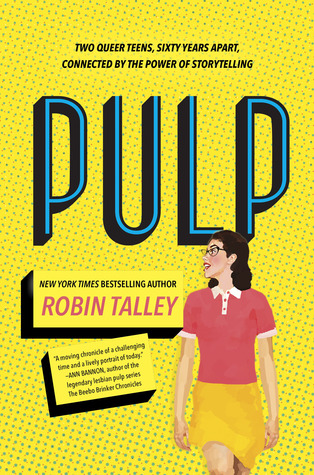Tags
“In 1955, eighteen-year-old Janet Jones keeps the love she shares with her best friend Marie a secret. It’s not easy being gay in Washington, DC, in the age of McCarthyism, but when she discovers a series of books about women falling in love with other women, it awakens something in Janet. As she juggles a romance she must keep hidden and a newfound ambition to write and publish her own story, she risks exposing herself—and Marie—to a danger all too real.
Sixty-two years later, Abby Zimet can’t stop thinking about her senior project and its subject—classic 1950s lesbian pulp fiction. Between the pages of her favorite book, the stresses of Abby’s own life are lost to the fictional hopes, desires and tragedies of the characters she’s reading about. She feels especially connected to one author, a woman who wrote under the pseudonym “Marian Love,” and becomes determined to track her down and discover her true identity.
In this novel told in dual narratives, New York Times bestselling author Robin Talley weaves together the lives of two young women connected across generations through the power of words. A stunning story of bravery, love, how far we’ve come and how much farther we have to go”

I got an ARC of this book.
I had an obsession with lesbian pulp novels in college. I may not have gotten as involved as Abby did about it, but I can see why she was so fascinated. The novels were one of the first times that gay people could see themselves in books. The censorship was unique in that there had to be a moral ending to right all the wrongs of the book, since being gay is this horrifying thing after all. It is perfectly ok to read hardcore homosexual erotica, as long as everyone dies. Obviously.
The book follows four groups of people, despite the cover mentioning two. The cover mentions Abby and Janet. The other two groups are the characters in the books that Abby and Janet write over the course of the novel. I tend to like the dual narrative or past and present that leads to a big reveal near the end. My issue with the book is it is SUPER repetitive. There were four main lesbian romances going on. Abby is obsessed with one of them and with the author of the book. So even during Abby’s sections those two stories are constantly brought up. Then during Janet’s sections, there is again Janet and her book. The only story that doesn’t get repetitive is Abby’s book, that is clearly not as fleshed out as the others, but that makes sense because she is writing it as part of the novel.
Abby’s plot itself was pretty meh. She is (not) dealing with the break-up with her first girlfriend, her parent’s impending divorce, or applying to college. She is a super activist and she is all about what she does. She learns some gay history 101 through the book, which doesn’t quite fit. If she is as super lesbian as she is portrayed and in a magnet school where she can study what she wants, how does she not know anything about Harvey Milk outside of there was a movie once? It just doesn’t fit the teen activist lesbians I knew as a teen or the ones I know now. They tend to be a lot more informed that Abby was about the history, especially about the history of their own label. Though Abby makes a great point that a lot of what is presented tends to be white and male gayness. You have to dig down to find the queer and the people of color. This is addressed a bit more in Janet’s story in such a wonderful way. I was impressed that race was tackled a bit considering Janet and Abby are both white and well off.
Janet’s plot is more what I want to read. It was more complex. She was dealing with first love without being able to talk about it or name it. She had nothing to help her navigate her world. She has that dramatic coming out and that dramatic story line that kept me captivated, even when she was talking about being a carhop. Her discovering pulp and her writing it was exactly what I was looking for.
If this book had half the plots, then it would have been so much easier to get through and would have been less repetitive. If Abby and Janet were the only plots, ignoring the details of their books, it would have taken some away from Janet’s story. But it would have made a totally different point of “look how drastically life has changed for queer people in such a short time. Learn your history, push forward”. If it were just Janet’s story, then I would have been in love. I didn’t need Abby or her not dealing with her issues. I didn’t care and her romance was just so annoying anyway. The book would have been a great historical fiction revolving around pulp novels and their important in queer history, total win. There were other ways this book could have gone, but the way it went was too bogged down in too many stories. It made it a little much for a YA. If this were an NA, then maybe. If Abby were in college and dealing with this and a bit more mature, I could totally have been all over it. It was just so close to being a book I could love. I did like it, but it was a little much at times.
It did make me hunt down some pulp novels and find one that I didn’t understand the first time I read it. I didn’t know what pulp novels were at the time. So I can only hope that this book inspires others to give the genre a chance or to learn about it in the first place.



3 out of 5 stars. I would recommend this book, maybe.
You can buy the book here.
~Isaiah
